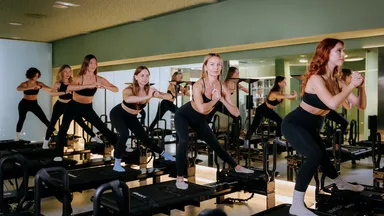
12 Types of Gyms: A Guide for Aspiring Gym Owners
Last updated: June 25, 2025
The fitness industry is a vast and diverse landscape that offers options to suit various preferences and fitness goals. By understanding the different types of gyms available, gym owners can tailor their services to meet the specific needs of their target audience, potentially leading to a more successful and profitable business.
Explore 12 different types of gyms
From traditional big box gyms to aerial and pole studios, each type has its own appeal. In this guide, we'll explore different types of gyms, shedding light on their characteristics, target demographics, and unique experiences.
1. Big box gyms
Big box gyms are known for their spacious facilities that offer a wide range of exercise equipment and amenities. These gyms typically provide diverse amenities like swimming pools, saunas and group fitness classes, making them appealing to various demographics, including beginners and seasoned fitness enthusiasts.
With their extensive equipment selection, big box gyms allow for autonomy in workouts and provide a one-stop shop for various routines. Since they are often part of a chain, they can offer more affordable memberships.
2. Boutique gyms
Boutique gyms differ from traditional big box gyms in that they are typically smaller and more community-oriented. They offer specialized fitness classes and individualized experiences, with varying intensity levels and workout routines such as one-on-one, small group, strength-based, and high-intensity training (HIIT).
Smaller class sizes allow for more personalized attention, fostering a sense of community among members. Boutique gyms stand out by providing a unique and engaging atmosphere that keeps clients returning for more.
3. CrossFit gyms
CrossFit gyms and fitness programs have become increasingly popular due to their high-intensity training and strength and conditioning workouts. Unlike typical gym sessions that target specific goals and muscle groups, CrossFit combines weightlifting and cardio exercises to enhance overall fitness and strength. These gyms provide a supportive and competitive atmosphere that emphasizes group workouts and motivates members to achieve their full potential.
4. 24-hour gyms
These gyms are designed to cater to the needs of people with varying schedules, allowing them to work out at any time of the day or night. 24-hour gyms typically prioritize providing essential equipment and services and are particularly convenient for those with busy lives. This makes them a practical choice for fitness enthusiasts who seek accessibility.
5. Yoga studios
Yoga is a spiritual practice that aims to bring harmony to the mind and body, making it one of the top 10 workouts of 2023. Yoga studios provide a serene environment that appeals to a diverse audience seeking mind-body balance. Experienced yoga instructors guide groups of individuals with varying skill levels through stretching poses, meditation, and mindfulness exercises.
6. Pilates studios
Pilates studios offer low-impact workouts that improve core strength, flexibility, and overall body conditioning. This exercise routine is becoming more popular and is considered the top workout of 2023. It caters to people with different fitness levels and focuses on controlled movements and proper form. Pilates studios use specialized equipment to enhance the workout experience. This workout routine attracts people who want to improve their fitness levels in a mindful and effective way.
7. Boot camp gyms
Boot camp gyms are known for their structured and dynamic group atmospheres. They utilize high-intensity, military-style workouts to challenge participants both mentally and physically. These classes are similar to circuit-training workouts and involve a combination of cardio and strength training exercises. Boot camps can take place outside or in a gym and cater to different ability levels.
8. Women and nonbinary gyms
Women-only and nonbinary gyms are less common than co-ed ones but they offer a unique and inclusive fitness experience tailored to people's needs and preferences. These gyms are specifically designed to meet the needs and preferences of women and nonbinary individuals. They create a comfortable, safe and supportive environment, providing various equipment, services, and facilities that support their fitness goals.
9. Small group and personal training gyms
Small group and personal training facilities offer one-on-one and small group training sessions, which allow trainers to customize workouts according to each individual's specific needs and goals. The small group training aspect creates a supportive and communal environment, while personal training sessions provide personalized attention and customized workout plans.
10. Powerlifting gyms
For powerlifting enthusiasts, powerlifting gyms offer the perfect environment to reach their fitness goals. Big box and boutique gyms offer a more general selection of dumbbells, barbells and weights. However, these gyms are equipped with more heavy-duty lifting equipment, such as deadlift platforms, powerlifting bars and competition-grade benches and squat racks, allowing powerlifters to pursue more significant gains with fewer limitations.
11. Mixed martial arts gyms
Mixed martial arts (MMA) gyms offer a combination of physical fitness and skill development in various martial arts disciplines. These gyms target individuals interested in self-defense, discipline, mental focus and overall physical conditioning. Classes may include karate, kickboxing, Brazilian jiu-jitsu and more. Additionally, MMA gyms allow contact with fellow athletes and instructors who are a constant source of motivation and inspiration.
12. Aerial and pole studios
Aerial and pole studios offer a unique and artistic approach to fitness. They provide classes in aerial silks, pole dancing and other aerial arts, combining strength, flexibility, and creativity. Aerial and pole studios are popular among those looking for a visually captivating and non-traditional workout experience.
Since these studios focus on bodyweight exercises and functional movements, they don't require traditional gym equipment. Instead, they have aerial apparatus like silks, hoops, hammocks and vertical poles.
Essential FAQs for future gym owners
How do I begin the process of opening a gym?
When starting a fitness business, following a few key steps is important to ensure success. The first step should be conducting thorough market research to understand the industry better. Once you know the market, you should create a comprehensive business plan that outlines your target audience, niche, pricing strategy, start-up costs, marketing plans, staffing needs, and more. This plan will help you stay organized and focused as you launch your business.
What are the start-up costs to open a gym?
Several factors contribute to how much it costs to open a gym. This includes the type of gym, location, facility size, equipment purchases, staff salaries, insurance, operating costs, etc. For example, opening a home-based gym or specialty studio, such as a yoga or Pilates studio, will typically carry less capital than opening a boutique or big box gym.
On average, you can expect to spend $15,000 to $50,000 in start-up costs for a specialty studio compared to $100,000 to $250,000 for a boutique gym.
How do I choose the right location for my gym?
When looking for a gym or studio location, think about how much foot traffic the area receives and if the location is easily accessible. You should also consider the space's square footage to ensure that it meets your gym's needs and that parking is available.
Most importantly, ensure the location is right for your target demographic. Take the time to analyze the area, your competition and rental or leasing costs. By doing so, you can make an informed decision and choose a location to help your gym thrive.
What marketing strategies are most effective for promoting a new gym?
A great way to start your marketing campaign is by building a brand and establishing an online presence. To achieve this, you should create a website and social media accounts on platforms like TikTok, Instagram, and Facebook. These channels will help your target audience understand who you are, the services offered and the environment they can expect from your gym or studio.
You can experiment with different tactics and platforms over time to determine what works and what doesn't.
What technology should I incorporate into my gym operations?
If you're planning to open a gym, incorporating technology into your operations can simplify processes, enhance the member experience, and improve efficiency regardless of the type of gym you choose. Consider implementing software for membership management, scheduling and booking, payment processing, fitness tracking, virtual training, and communication with members.
Reliable gym management software can help streamline your business functions. For instance, Mindbody provides an all-in-one management platform that supports marketing, staff management, payments, booking scheduling and more.



